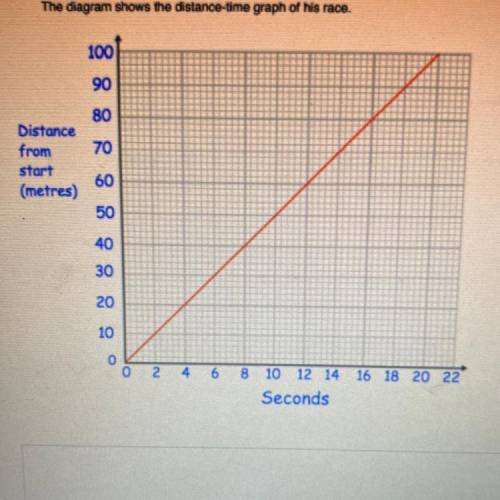
Physics, 08.10.2021 14:10 anastasiakonni1
Henry ran a 100 m race. Use the graph to answer the following:
a. How long did it take for Henry to run 100 m?
b. What is Henry's average speed over the race?


Answers: 1


Another question on Physics


Physics, 22.06.2019 07:30
Some material consisting of a collection of microscopic objects is kept at a high temperature. a photon detector capable of detecting photon energies from infrared through ultraviolet observes photons emitted with energies of 0.3 ev, 0.5 ev, 0.8 ev, 2.0ev, 2.5ev, and 2.8ev. these are the only photon energies observed. (a) draw and label a possible energy-level diagram for one of the microscopic objects, which has four bound states. on the diagram, indicate the transitions corresponding to the emitted photons. explain briefly. (b) would a spring–mass model be a good model for these microscopic objects? why or why not? (c) the material is now cooled down to a very low temperature, and the photon detector stops detecting photon emissions. next, a beam of light with a continuous range of energies from infrared through ultraviolet shines on the material, and the photon detector observes the beam of light after it passes through the material. what photon energies in this beam of light are observed to be significantly reduced in intensity (“dark absorption lines”)? explain briefly.
Answers: 3

Physics, 22.06.2019 12:00
Asolid round steel rod 6.25 mm in diameter and 375 mm long is rigidly bonded to the end of solid square brass rod 25 mm on a side and 300 mm long. the geometric axes of the bare are along the same line. an axial tensile force of 5.4 kn is applied at the extreme ends of the assembly. for steel e = 200 gpa and for brass e = 90 gpa. determine the total elongation for the assembly.
Answers: 1

Physics, 22.06.2019 15:00
Astudent throws a water balloon with speed v0 from a height h = 1.76 m at an angle θ = 21° above the horizontal toward a target on the ground. the target is located a horizontal distance d = 9.5 m from the student’s feet. assume that the balloon moves without air resistance. use a cartesian coordinate system with the origin at the balloon's initial position. (a) what is the position vector, rtarge t, that originates from the balloon's original position and terminates at the target? put this in terms of h and d, and represent it as a vector using i and j. (b) in terms of the variables in the problem, determine the time, t, after the launch it takes the balloon to reach the target. your answer should not include h. (c) create an expression for the balloon's vertical position as a function of time, y(t), in terms of t, vo, g, and θ. (d) determine the magnitude of the balloon's initial velocity, v0, in meters per second, by eliminating t from the previous two expressions.
Answers: 3
You know the right answer?
Henry ran a 100 m race. Use the graph to answer the following:
a. How long did it take for Henry t...
Questions







Arts, 13.05.2021 23:30


Mathematics, 13.05.2021 23:30


Chemistry, 13.05.2021 23:30

Computers and Technology, 13.05.2021 23:30

Mathematics, 13.05.2021 23:30

Mathematics, 13.05.2021 23:30

Mathematics, 13.05.2021 23:30

Mathematics, 13.05.2021 23:30







